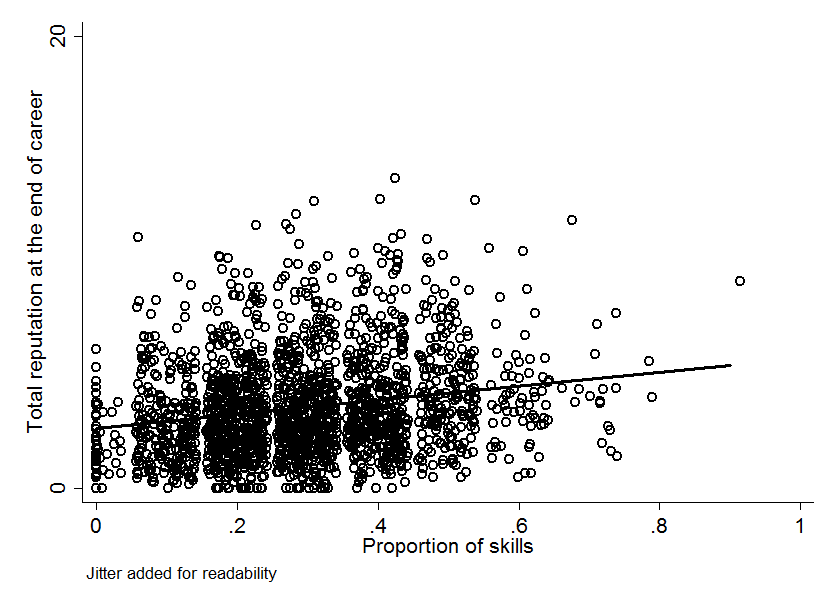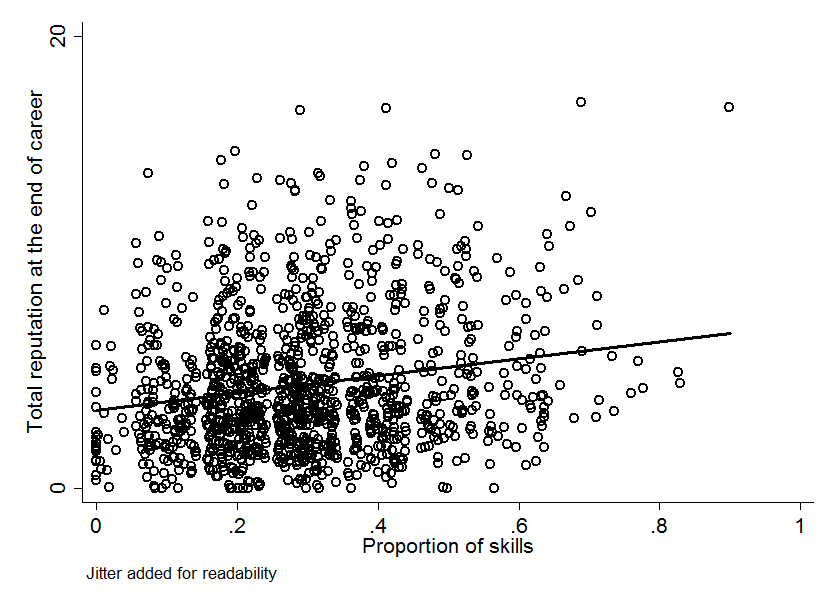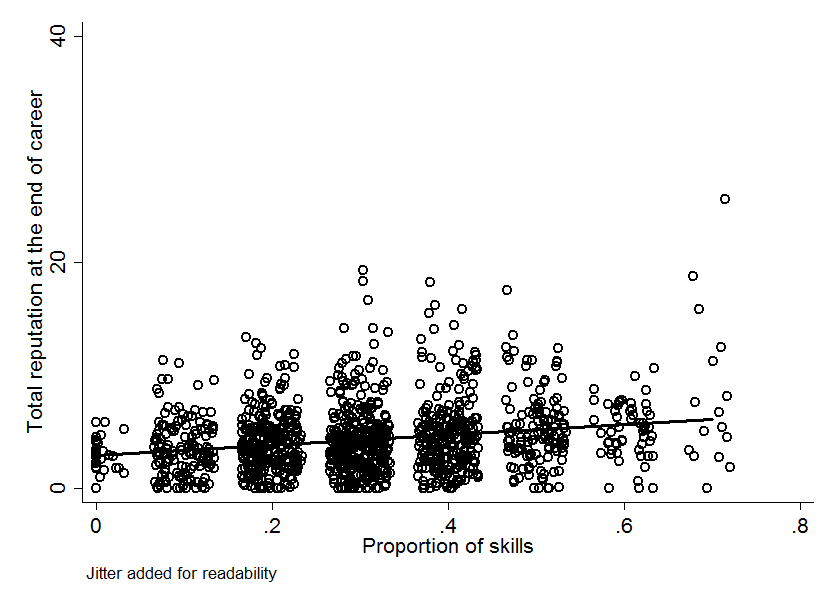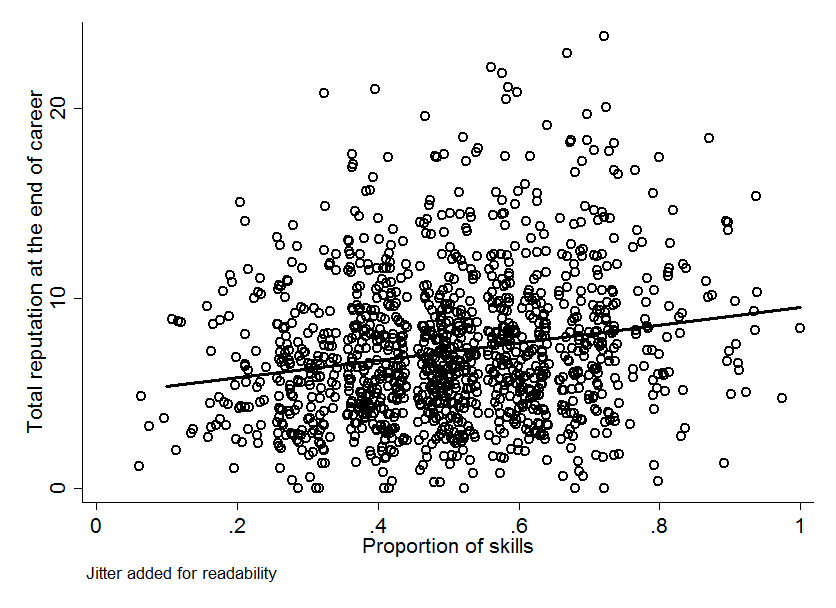Teams with heterogeneous skills and preferences
Maxim Kuklin and Toban Wiebe
Introduction
People work in teams because it increases their productivity. Presumably, they are more productive not only because of sheer scale, but because of complementarities in their skills which allow them to specialize and divide up their work. On the other hand, teams are often beset by conflicts which hamper their productivity. We present a simple agent-based model to study how people sort themselves into teams based on both complementarity and compatibility under incomplete information.
We consider the case in which agents have differing risk preferences, reflecting different risk-reward tradeoffs. Agents are randomly assigned to teams in each period, but they may blacklist other agents with whom they do not wish to work, either due to incompatibility of risk preferences or to non-complementarity of skills. Agents have a reputation score which can rise or fall depending on the quality of the team output.
Model
A population of agents are randomly assigned to teams for joint production. You can think of this as a model of academics coauthoring papers or a large firm assigning workers to small teams. There are relevant skills, and each agent’s skills are represented by a binary vector . There are two risk types risk represented by the binary variable . The probability of being the risk averse type is . Reputation evolves according to quality of outputs and is denoted by .
This game is played repeatedly, with agents being randomly assigned to teams of various sizes and then blacklisting teammates based on project risk and output quality . Agents are born at age and age increases by each period. Reputation starts at and skills are drawn independently with probability . Death occurs with age dependent probability , where is some maximum lifespan imposed by the model and . The dead are immediately replaced by a new agent, so that remains constant.
Reputation evolves as the average of an agent’s lifetime share of output. Output (quality) is random and depends on the team’s skill set and the joint level of risk, which is aggregated over each skill domain as follows: if an agent possesses a skill, they have a say in the risk level in that domain, and their relative reputation is the weight that gets placed on their preferred risk in that skill domain. Then the risk levels in each skill domain are averaged to arrive at an overall risk for the team project. For a team , if is the team risk in skill domain , then the overall team risk level is
Note that if the team lacks the skill, then that domain is excluded from the risk averaging.
A team’s skill set is simply the proportion of skills that at least one of its members possesses.
Team productivity is defined as for some . Convexity in the production function makes team formation more valuable (greater skill coverage) relative to team size. As the team payoff will be divided among members evenly, this makes productivity increase in team size for small team sizes. However, once teams reach full skill coverage, each additional member is just diluting the payoff, and so productivity declines beyond some optimal average team size.
Finally, for some parameters and , project quality is drawn randomly and reflects the risk-reward tradeoff:
Agents then divide up the product and average their share into their reputation score, the same way that a student would average in a new course grade into their grade point average (we use the prime notation in the usual way, to refer to a next-period variable):
Example
Suppose there are skills and agents form a team. This table shows how the productivity and risk level are computed from individual skills, risk types, and reputations.
| 1 | 0 | 1 | 1 | 0 | |
| 0 | 1 | 1 | 1 | 1/2 | |
| 0 | 0 | 0 | 0 | 0 | |
| 1 | 1 | 0 | 1 | 1/3 | |
| 0 | 1 | 0 | 3/4 | 5/18 | |
| 1/2 | 1/4 | 1/4 |
Here, the team risk aggregates to and productivity is .
Agent behavior
We conceive of agents as not observing the attributes of others. They only observe their team’s project risk and resultant (random) quality . Agents will blacklist teammates based on two behavioral rules:
- Risk preference compatibility: blacklist teammates if
- Quality per member: blacklist teammates if
Each agent uses both rules and blacklists if either one is satisfied. The first rule says that an agent will blacklist teammates if the team risk is too far away from his own preferred risk. In the example above, agent will blacklist if , because (the team is too conservative). The second rule says to blacklist if the marginal reputation from the team project is less than some proportion of your current reputation. This could happen because of team skill gaps or because of risk.
This means that the most stable teams are the ones that have complementary skills but take very low risk: they are then very unlikely to get a bad draw of project quality. On the other hand, a team with good skill coverage that takes high risks is bound to eventually draw a low project quality that will result in blacklisting. Depending on death rates, this effect may or may not come into play.
Simulation
We simulated the agent-based model in NetLogo. Due to the large number of model parameters, we have so far only completed an exploratory analysis of the model.
The baseline simulation uses
- Number of agents:
- Probability of each skill:
- Number of skills:
- Probability of risk-aversion:
- Convexity of production function:
- Retirement age:
- Convexity of death rate:
- Blacklisting thresholds:
Random matching works as follows: a team size between 1 and 4 is drawn randomly (uniform) and then agents are selected at random to fill in the team, respecting each agent’s blacklist. If the team can not be fully filled due to there being no acceptable agents in the population, the team is left at its current size and the algorithm repeats, drawing the next team, until the pool of agents is exhausted.
Who does best?
One interesting result of the model is that, while reputation is higher on average for those with more skills, due to the randomness of the model, the agents with the highest reputation have an intermediate amount of skills. This result holds across all of the parametrizations we explored.
This is mainly due to the fact that the number of skills possessed is distributed binomially in the population, so that there are far more agents with intermediate amounts of skill. Another factor whose importance is yet to be explored, is that agents with many skills will have more influence on team risk (because they get a say in the risk level of each skill domain.) This creates a “my way or the highway” effect — agents with the opposite risk preference will find that being on a team with a high-skilled individual results in unfavorable project risk. So high-skilled individuals will tend to be blacklisted by those of the opposite risk preference.
Baseline

The scatterplot above (baseline model) shows how reputation is distributed among various skill levels.
Short careers

With shorter careers (), agents have less time to sort themselves into compatible and complementary teams, and so reputations are lower across the board.
Penalizing skill gaps

With a larger skill gap penalty (), reputations are lower across the board, but the relative distribution of reputation does not change much.
More risk aversion

With a greater proportion of risk averse agents (), reputations are lower across the board. This is counter-intuitive, as more like-minded agents should find it easier to cooperate.
Higher skill levels

With a greater chance of having any given skill (), reputations improve across the board.
Conclusion
More exploration of the parameter space is necessary to understand the model. Then further work can focus on adding richness to the model, as it is deliberately quite simple here.
Written with StackEdit.